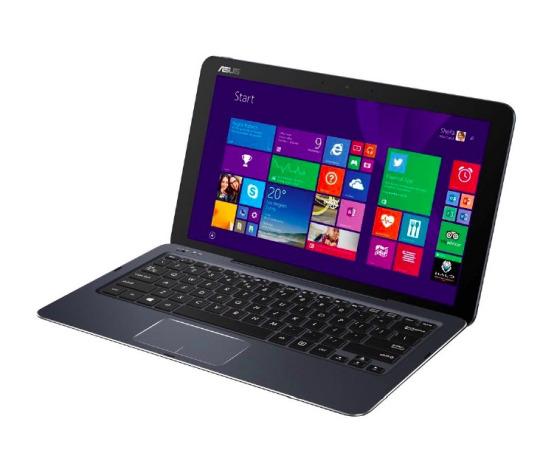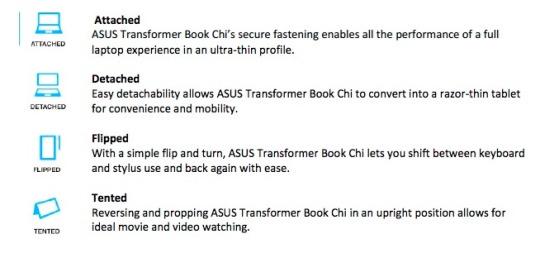Asus Transformer T300 Chi: An Inexpensive Yet Awkward Tablet Hybrid
Asus wants to help you align your chi — specifically, with its new Transformer Book T300 Chi, a tablet/laptop hybrid with a detachable wireless keyboard.
The T300 is one of the first machines to use the new Intel Core M chip, designed
for two-in-one machines. The M chip allows hybrids to run cooler and
quieter (no fan in this machine) and is said to offer a longer battery
life. More on that below.

(Asus)
It’s
certainly easy on the eyes. Asus says the 7.6mm T300 is the world’s
slimmest Windows tablet; even with a keyboard attached it’s still
thinner than the MacBook Air. An all-aluminum diamond-cut chassis has
soft, roundcorners and a nice smooth feel. The 12.5-inch
tablet/touchscreendisplay looks gorgeous. Its price includes a
terabyteof online storage. And at $699 for the 4GB model, it’s
competitively priced, though not the cheapest hybrid on the market.
So
what’s not to like? For one thing, it’s still a Windows 8.1 machine,
although it will be upgradable to Windows 10 when the new OS appears
sometime this summer. It comes with only trial versions of Office apps,
so if you want this machine for work you’ll probably need to add the
price of an Office 365 subscription ($100 a year) to the cost. It’s also
a bit heftier than other hybrids in its class. And like a teenager
after a growth spurt, it can be gangly and awkward.
Tale of the tape
Let’s
take a look at the Chi’s specs. The T300 Chi comes with 4GB or 8GB of
memory, 128GB solid-state storage, and a Core M 5Y71 processor running
at 1.2GHz. The Core M chip is criticized by nerds for being underpowered
relative to the i3 or i5 chips in other laptops, but I found
performance perfectly acceptable, even when playing midlevel games like Asphalt 8: Airborne. You probably don’t want to use it to edit video or play graphically intensive games, though.

(Asus)
The
T300 weighs in at 3.2 pounds, which is divided almost evenly between
the tablet and the keyboard. That’s twice the weight of Microsoft’s 10.8-inch Surface 3 and heftier than the much pricier 13-inch Lenovo Yoga 3 (2.6 pounds) and even the MacBook Air (2.9 pounds). Despite its thin profile, the T300 needs to cut back on the carbs.
The
gorgeous 12.5-inch WQHD display (2560x1440) would make the T300 a great
personal home theater device, if not for the puny 2-watt speakers that
provide just enough sound for one person sitting in a quiet room. Asus
bundles an Audio Wizard app that improves the sound a little, but not
enough. You’ll want to wear headphones.
Asus
is claiming a top battery life of eight hours for the T300, which isn’t
exactly knocking it out of the park these days. In our casual testing,
though, we got between five and six hours of juice using the device’s
default setting (“balanced”). If you want eight, you’ll probably have to
run it in power-saving mode most of the time.
On
the other hand, the keyboard has its own battery that lasts for an
insane 84 hours of nonstop typing, so you don’t have to worry about it
dying while you’re watching the computer’s battery dwindle. The
full-sized keyboard is surprisingly solid; this gives it a nice feel
when you’re banging out text but also makes the whole unit bulkier than
slim keyboard models like the Surface 3.

(Asus)
The
T300 rounds out the package with micro USB, HDMI and SD ports; an
audio-combo jack; and a front-facing 2-megapixel camera. Accessories
include a stylus ($40) and cases ($40 to $50).
Pose and cons
Because
this is a two-in-one with a removable wireless keyboard, you can
configure the T300 in more poses than a Vicky’s Secret fashion model.
Unfortunately, most of them are pointless.
First,
you can use it like a traditional laptop. The screen extends to about a
105-degree angle, which is OK but less than most pure laptops. Even
then, you won’t want to walk around carrying this in one hand with the
screen open, as so many people do with their MacBooks. The large display
makes it too top-heavy; at any moment I was afraid it would tumble out
of my hands.

(Asus)
You
can separate the wireless keyboard from the tablet, so you can keep it
in your lap as you type. But unlike Microsoft’s Surface, the tablet
doesn’t have a “kickstand,” so you’d need to lay the screen flat or prop
it up on something. Can you say awkward?
You
can detach the screen, flip it horizontally, reattach it, and fold it
back onto the keyboard, covering the keys. This allows you to hold the
T300 vertically like a digital clipboard, then reassemble it later when
you need to type. But the 12.5-inch screen is really too bulky and heavy
for this kind of action; I can’t see many people doing this. It’s much
easier to just take the keyboard off and use it as a tablet by itself.
You
can also “tent” the unit — fold the keyboard behind the screen in an
upside-down V so you can use it as a touchscreen display. The problem?
The T300’s power button is on the top of the tablet (which then becomes
the bottom edge when you fold it into a V). So every time you set the
thing down on a hard surface the screen goes dark. Hello, Asus
designers, anybody home?
Your
best option, especially if you want to use the T300 to watch movies
when you’re not typing, is to attach the display as if you’re going to
turn it into a digital clipboard and then fold it back at a roughly
60-degree angle.
Chi whiz
Bottom
line: The T300 is a decent enough computer but nothing to get excited
about. If you want a portable Windows machine that does double duty as a
tablet and a laptop, the Surface 3 is cheaper and more portable.
If
you’re looking for a backpack-friendly computer for a student, you
might consider the T100 Chi. This 10-inch twin to the T300 features an
Intel Atom processor, an alleged battery life of up to 10 hours, and one
year of Office 365; it sells for $399.
Editor's note: This article has been updated to correct information about the Chi accessories and T100 processor.
No comments:
Post a Comment